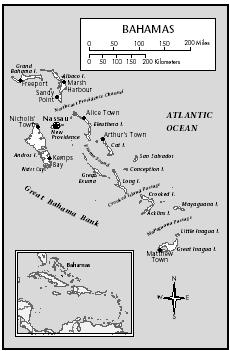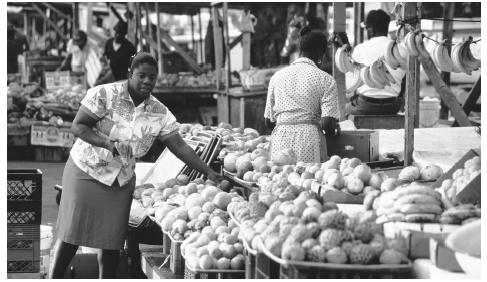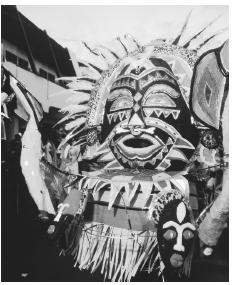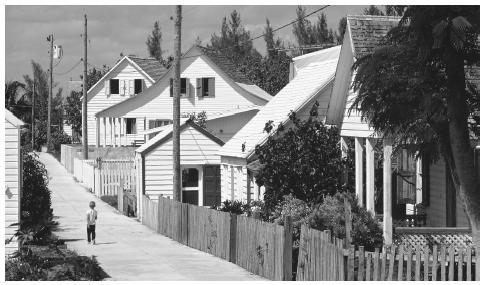Bahama Islands
Culture Name
Bahamian
Orientation
Identification. The name Bahamas derives from the Spanish baja ("shallow") and mar ("sea"). Within the country, a distinction is made between the capital of Nassau on New Providence Island and the out islands of the archipelago. Bahamians recognize their distinctive national culture but emphasize minor differences in speech and customs among the islands. Foreign-born residents from the United Kingdom, the United States, Haiti, Canada, and other countries are referred to by their original nationalities regardless of citizenship or assimilation.
Location and Geography. The Bahamas lie in the Atlantic off the eastern coast of Florida and extend for over seven-hundred miles, roughly parallel to Cuba. The archipelago consists of approximately seven hundred islands and cays, plus nearly 2,400 reefs and rock formations. The land area is 5,382 square miles (13,940 square kilometers). There are fourteen island groupings. The climate is subtropical, with a hurricane season from June through November. Flooding is a problem because the islands are low outcrops of limestone, with most settlements barely above sea level. Farming has been practiced since pre–Columbian times, but the soil is thin, sandy, and not fertile. Few of the islands have ground water. The islands are ringed by sandy beaches and surrounded by shallow seas.
Demography. Population estimates range from 275,000 to 325,000, with tens of thousands of illegal economic refugees from Haiti who account for 20 to 25 percent of the population. About 85 percent of Bahamians are of African ancestry, and most of the remainder are of European descent. People of Asian ancestry constitute a very small segment of the population. Some racial mixing has occurred. Approximately 60 percent of the population is urban, a proportion that is growing rapidly as young adults migrate from out-island settlements to the urban areas of Nassau and Freeport.
Linguistic Affiliation. English is the primary and official language. Regional and class-related dialects vary from "Standard English" among the urban elite to "Bahamian English" among the poorer people. There are finely nuanced differences in vocabulary and pronunciation from island to island. "French Creole" is spoken by immigrants from Haiti. Those immigrants often are able to converse in heavily accented English, but few have been formally educated in the language.
Symbolism. Residents sometimes use the term "family islands" to symbolize the desired unity of the scattered population and the image of small, cohesive out-island communities. One of the most familiar symbols is the national flag, which was introduced in 1973. The left side consists of a black triangle with a horizontal yellow stripe flanked by two bright blue stripes. Yellow symbolizes the sunny climate, and blue symbolizes the sea. Many people assert that black symbolizes the African heritage of the people. "Junkanoo" is a Mardi Gras-like celebration that is held on several secular holidays. Both the term and form of the celebration probably come from West Africa. The celebrations combine music, costume, dance, revelry, pride in the African cultural heritage, recognition of slave resistance to authority, and the unity of the people. Junkanoo "gangs" compete for prestige and cash prizes. Tourism officials have transformed these ceremonies into events that draw thousands of visitors. Organizers, scholars, and participants refer to Junkanoo as a social institution that binds the people to each other and to their past.
History and Ethnic Relations
Emergence of the Nation. The first residents were the Lukku-Cairis, or Lucayans, a subdivision of the

National Identity. National culture was forged through the interactions of British and African traditions. Britons contributed the English language, Protestantism, a market economy, and European technology. Various West African peoples contributed musical instruments and styles, forms of dance, religious concepts, folktales, family patterns, and linguistic influences. New beliefs and behaviors emerged within the Bahamian context as well. Plantations, slave revolts, colonial governance, the insular existence, the sea, hurricanes, and many other elements contributed to the cultural synthesis. The islands remained a British colony until independence was peacefully attained in 1973.
Ethnic Relations. Many Bahamians perceive Haitians in terms of negative stereotypes and consider them scapegoats. Haitians often are portrayed as violent, uncivilized, and inclined toward criminality. Because of their poverty, they often do work Bahamians see as undesirable, and thus they are blamed for taking away jobs. Because they speak French Creole and practice voodoo, they are deemed secretive and dangerous. They also are seen as clannish and as a criminal menace. It often is stated that AIDS arrived with the refugees. Americans, whether in the Bahamas as tourists or on business, are seen in a more ambivalent way. Their money is desired, but their influence is not appreciated. Tourism-sector jobs are essential but are perceived as colonialism in modern dress. American investors and businesspeople are portrayed as arrogant, brash, and overly concerned with dominating Bahamians.
Urbanism, Architecture and the Use of Space
The population is over 60 percent urban, with over half the people living in the capital city, Nassau. The only other city is the tourism-oriented Freeport. The rest of the population is scattered among dozens of smaller settlements ranging from small villages to regionally important towns. Nassau has neighborhoods that range from exclusive enclaves for the extremely wealthy to slums inhabited by the chronically unemployed and underemployed. Construction materials are roughly evenly divided between limestone and wood. Because of hurricanes, tall buildings are rarely constructed. Where feasible, buildings have porches and many windows. Old colonial structures, from forts to public buildings to houses, are revered. Termites and heavy winds have destroyed many structures, and cement block buildings have become commonplace. Public places such as narrow streets, beaches, and parks encourage human interaction.
Food and Economy
Food in Daily Life. Typical meals for urban residents consist of fruits and vegetables, meat or fish, bread, and rice. Out islanders tend to eat more fresh fruit, vegetables, and fish. The two national dishes are conch, an easily collected sea snail, rice, and peas. Poor people eat these foods because they are inexpensive and readily available; the more affluent enjoy them as "heritage foods."
Food Customs at Ceremonial Occasions. Holiday meals tend to center on local fish or conch, rice and peas, baked goods, and fresh fruit. Bahamian rum, local and imported beer, soft drinks, tea, and coffee are regularly consumed.
Basic Economy. Most consumer goods are imported. Farming is unimportant except for a small amount of subsistence gardening in out-island settlements. Tourism accounts for about half the gross domestic product and nearly half of all jobs. The annual per capita income is approximately $10,000, there is little taxation, inflation ranges between 5 and 10 percent, and the unemployment rate is 15 to 20 percent. The national currency is known as the Bahamian dollar
Commercial Activities. Commercial farming of cotton, pineapples, and sisal has had little success. Commercial fishing is moderately important, with most of the catch frozen and exported. Sponge fishing is nearly defunct. Cottage industries that produce straw, shells, and wooden items cater to local residents and tourists. Hotels, casinos, restaurants, and sport fishing businesses are common.
Major Industries. Manufacturing is unimportant except for a few oil refineries and small factories. Offshore banking and finance are important because favorable tax and corporate laws have been established and widely promoted.
Trade. Most consumer goods are imported. Goods such as pharmaceuticals, rum, crawfish and cement are exported. The major trading partners are the United States, the United Kingdom, and Canada.
Division of Labor. The government is the largest employer. Out-island children work with their parents or grandparents when they are not in school or at play. In towns and cities, children from poorer families may work as street vendors or do odd jobs. Some occupations are unionized, and unions are an important force. Skilled trades such as fishing, carpentry, and masonry work tend to be family specializations. Small businesses pass from generation to generation within families.
Social Stratification
Classes and Castes. The upper class consists of wealthy business owners, corporate managers, professionals, high-ranking government officials, and some foreign citizens. Historically, this class was composed of Britons, white Bahamians, light-skinned Bahamians of mixed race, and a few Americans and Canadians. Most were self-consciously British in speech and behavior. The upper class today includes many more residents of African ancestry. Emulation of the old colonial elite is less common. The middle class consists of small business owners, some professionals, civil servants, and lower-level corporate managers. Most members of this class are of African ancestry, but some are of European and Asian ancestry. Degrees from Bahamian and American colleges are increasingly common. The lower class is the nation's largest and includes roughly equal numbers of urban and out island residents. Almost all the members of this class are of African ancestry. Lower-class Bahamians include fishermen, farmers, laborers, skilled tradespeople, and others who do low-status physical work. Some have high school diplomas, but many have lower levels of educational attainment and are perceived as poor but respectable. The lowest stratum is an underclass that consists of the chronically unemployed and Haitian refugees. Most members of the underclass live in the least desirable and "respectable" sections of the Nassau metropolitan area. They are found in smaller numbers in some out-island communities. Few have a high school diploma.
Symbols of Social Stratification. The distinction between old money and new money is not critically important. University degrees, especially from private institutions in Britain and the United States, are common. Most upper-class residents are in the exclusive neighborhoods of Nassau, although some have additional homes in the out islands or abroad. Middle-class people live in "respectable" Nassau neighborhoods or out-island settlements. Many regularly fly to Florida for shopping and entertainment.
Political Life
Government. The Commonwealth is a constitutional, parliamentary democracy with universal suffrage for citizens age eighteen and older. The British monarch is recognized as the head of state and is represented by the governor-general, but executive power is vested in the prime minister. Primary legislative authority resides with an elected

Leadership and Political Officials. There are two major political parties: the Free National Movement (FNM) and the Progressive Liberal Party (PLP). Ideologically, both parties are centrist, with the PLP somewhat to the left of the FNM on most social issues. The personalities of politicians and their relationships with constituents are more important than political philosophy. Most people elected to the House of Assembly since independence have been middle-aged men of African ancestry with university degrees and successful careers in law and/or business. House members need not reside in their districts but normally visit frequently. Political officials are expected to be accessible to their constituents through office visits and the mail.
Social Control and Problems. Bahamian law is based on English common law and statute law. The law is enforced via the paramilitary Royal Bahamas Police Force and federally appointed constables. Legal prosecution is carried out by the attorney general's office. Informal social control occurs through peer pressure, gossip, and fear of harmful magic known as obeah . The archipelago is the final staging area for thousands of annual shipments of illegal drugs from South America and the Caribbean to North America. Although illegal and viewed as a social problem by many people, the drug trade is tolerated because it provides income. Money laundering and related international crimes are widely viewed as beneficial and are not criminalized. Crimes such as assault, robbery, and homicide are dealt with routinely. Vigilante groups exist but are not an important aspect of social control.
Military Activity. No military exists and Bahamians rely on the protection of the United Kingdom.
Social Welfare and Change Programs
The government has a program of moderate social welfare and change initiatives. The 1990s witnessed education reforms stressing vocational and technical training to combat unemployment and reliance on foreign workers. The low level of taxation and the cultural value attached to independence preclude more elaborate programs.
Nongovernmental Organizations and Other Associations
Nongovernmental organizations such as churches and labor unions have modest programs of local reform ranging from refugee relief to antidrug initiatives. Regional ad hoc committees lobby for government projects and environmental protection.
Gender Roles and Statuses
Division of Labor by Gender. Legally, women have equal status under the law, but men tend to dominate the higher-income and higher status positions in the public and private sectors. Men dominate fishing and other maritime endeavors, the building trades, and the transportation industry.
The Relative Status of Women and Men. Urban women have many career opportunities and are not discriminated against in obvious ways. Women dominate fields such as nursing, elementary school teaching, and office work. Out-island women tend to be farmers, shopkeepers, craft specialists, and domestics when they are employed. Many self-identify as "housekeepers."
Marriage, Family, and Kinship
Marriage. Marriages are monogamous. In many out-island settlements, the options are marriage and extraresidential unions. In larger towns and cities, consensual unions exist. People are free to select their spouses. Church weddings follow brief engagements. In principle, one should not marry a blood relative, but in small communities marriages between kin more distantly related than first cousins are common. In white-dominated out-island settlements, interracial marriages are stigmatized. Both partners are expected to contribute financially to a marriage. Divorces are available, although many couples simply drift apart and never legally terminate the union. There is no stigma attached to remarriage. A sexual double standard exists in which women are supposed to be chaste until marriage and faithful during marriage whereas men are expected to have premarital and extramarital affairs. Men are widely seen as inherently promiscuous.
Domestic Unit. The ideal is the nuclear family household. In cases of extramarital unions, consensual unions, divorce, death, and abandonment, matrifocal households are common. In poorer out-island settlements, parents may move to urban areas to work, leaving their children in the care of

Inheritance. Sons and daughters inherit from both parents. Inherited property includes land, houses, boats, and household goods. Wills may favor one heir over another, but this is uncommon, especially in the out islands.
Kin Groups. No formal kin groups larger than the family exist. Adult siblings tend to look after each other's interests and frequently operate shops or fishing vessels together.
Socialization
Infant Care. Infants are cared for by their mothers. Both bottle feeding and breast-feeding are accepted. Infants sleep in the parents' bedroom except among the more affluent, where a separate room is available. Infants are carried in the arms, and baby carriages are used. Caregivers try to calm crying or otherwise agitated infants.
Child Rearing and Education. Children are socialized in traditional adult roles. Girls care for younger siblings, play with dolls, and help with

Higher Education. Since independence, higher education has been stressed. The College of the Bahamas in Nassau and numerous technical schools provide higher education, although foreign universities are popular among the more affluent.
Religion
Religious Beliefs. Most residents are churchgoing Christians. About 80 percent are Protestant, and 20 percent are Roman Catholic. The largest Protestant denominations are Baptist and Anglican. Obeah is an African system of belief in spirits that often is superimposed on Christianity.
Religious Practitioners. Large congregations are led by ordained ministers and priests, while small congregations are led by unordained preachers. Obeah men are part-time specialists whose activities include placing and removing curses, communicating with spirits, and giving spiritual advice.
Rituals and Holy Places. Most rituals are Christian services and are held in churches. Immersion baptisms and revival meetings are held outdoors. Some Christian services include glossolalia, spirit possession, and faith healing. Obeah rituals tend to be small and private.
Death and the Afterlife. The dead are placed in simple pine coffins, and wakes are held at home. The wealthy buy more expensive coffins and use funeral parlors. Funerals are held in churches, and burials are in churchyards or public cemeteries. It is believed that souls go to heaven or hell, but some believe that ghosts wander before reaching their ultimate destination.
Medicine and Health Care
There is one large hospital in Nassau, and over a hundred government clinics are scattered elsewhere. An air ambulance service transports out islanders to the hospital in emergencies. There are about twelve-hundred people per physician, but nurses and paramedics often serve as primary care professionals, especially in remote settlements. "Bush medicine" (herbal treatments) is still found, but its popularity is declining.
Secular Celebrations
Ten public holidays are recognized: New Year's Day, Good Friday, Easter, Whit Monday (seven weeks after Easter), Labor Day (first Friday in June), Independence Day (10 July), Emancipation Day (first Monday in August), Discovery Day (12 October), Christmas Day, and Boxing Day (26 December). Secular holidays tend to be celebrated with parades, speeches, and concerts.
The Arts and Humanities
Support for the Arts. Artists tend to be self-supporting, although government grants occasionally are given for works of special public significance.
Literature. Oral literature, the telling of "old stories," is a revered art form. Written works include historical novels and poetry.
Graphic Arts. Graphic arts, especially painting, tend toward landscapes and seascapes and historical events. There are many private gallaries in Nassau.
Performance Arts. Plays are performed for tourists and residents at amateur and professional theaters in Nassau and Freeport. Concerts range from youth-oriented popular music (reggae, rock, rap) to more adult-oriented forms (blues, jazz, gospel) to classical music. The largest events are held in Nassau and Freeport, but smaller concerts are held in most out-island communities.
The State of the Physical and Social Sciences
Faculty members from the College of the Bahamas conduct a limited amount of scientific research. More is conducted by foreign researchers, especially marine biologists. Social science research tends to be in applied fields such as economic development, finance, social work, and public health. Medicine and engineering are not well developed.
Bibliography
Collinwood, Dean W. The Bahamas Between Worlds, 1989.
——, and Steve Dodge, eds. Modern Bahamian Society, 1989.
Craton, Michael. A History of the Bahamas. 3rd ed., 1986.
——, and Gail Saunders. Islanders in the Stream: A History of the Bahamian People, vol. 1, 1992.
Crowley, Daniel. I Could Talk Old Story Good: Creativity in Bahamian Folklore, 1966.
Dupuch, S. P., editorial director. Bahamas Handbook and Businessman's Annual, 1998.
Holm, John A. and Alison Watt Shilling. Dictionary of Bahamian English, 1982.
Hughes, C. A. Race and Politics in the Bahamas, 1981.
Johnson, Doris. The Quiet Revolution in the Bahamas, 1971.
LaFlamme, Alan G. Green Turtle Cay: An Island in the Bahamas, 1985.
Otterbein, Keith F. The Andros Islanders, 1966.
—A LAN L AFLAMME
Do I need a visa. How long I can stay in Bahamas. Which is the best Island to visit?